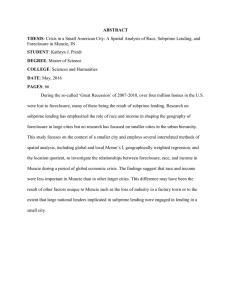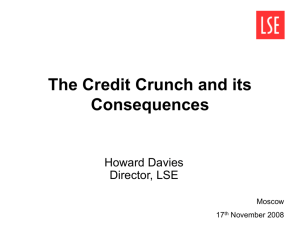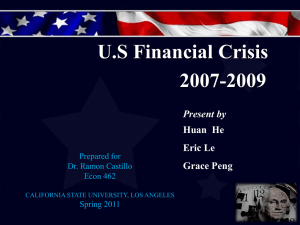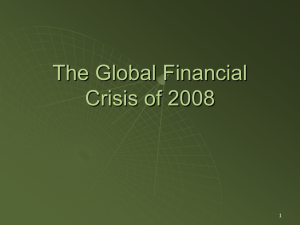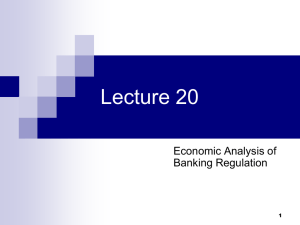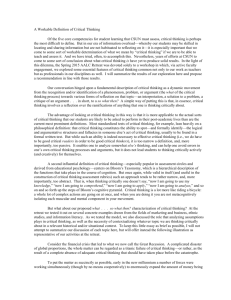Subprime Lending: Neighborhood Patterns Over Time in US Cities
advertisement
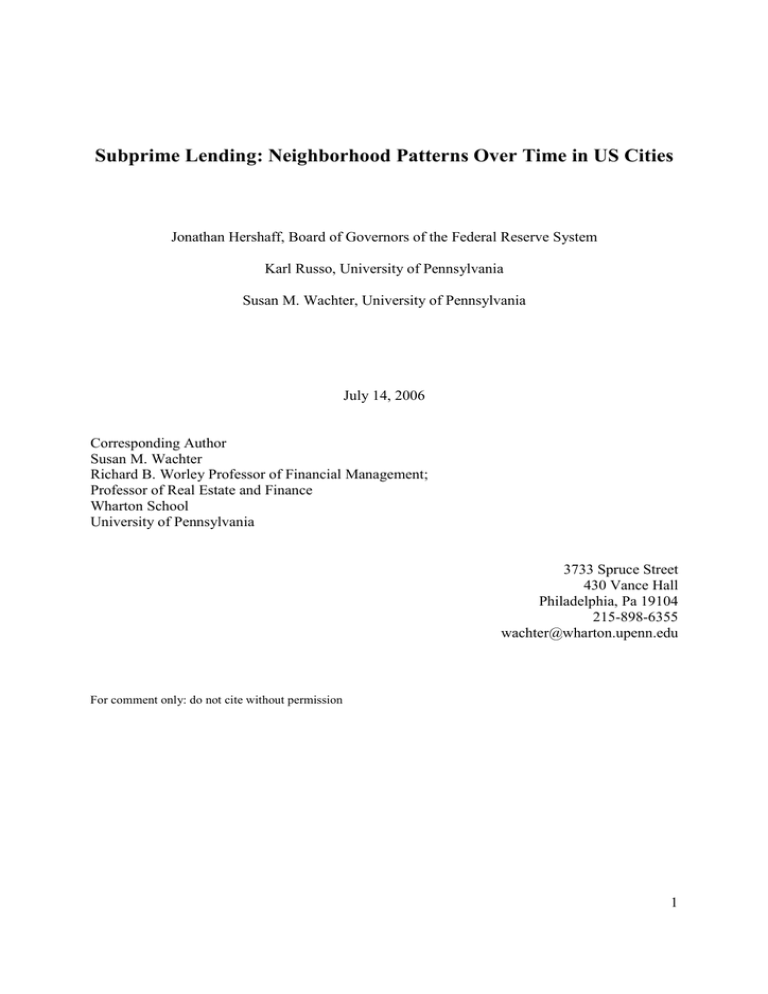
Subprime Lending: Neighborhood Patterns Over Time in US Cities Jonathan Hershaff, Board of Governors of the Federal Reserve System Karl Russo, University of Pennsylvania Susan M. Wachter, University of Pennsylvania July 14, 2006 Corresponding Author Susan M. Wachter Richard B. Worley Professor of Financial Management; Professor of Real Estate and Finance Wharton School University of Pennsylvania 3733 Spruce Street 430 Vance Hall Philadelphia, Pa 19104 215-898-6355 wachter@wharton.upenn.edu For comment only: do not cite without permission 1 Abstract Subprime lending serves those with relatively high credit risk and therefore entails higher borrowing costs. This market has grown tremendously over the past decade, although with substantial variation in growth rates across the central cities of metropolitan areas in the US. Previous research has focused on specific cities and has shown that subprime lending historically occurs disproportionately in areas with higher risk, lower income and larger shares of minority households. This paper extends the literature by conducting a nation-wide study of how subprime lending patterns have changed over time across all US central cities. We find subprime lending growth is higher in urban census tracts with higher percentages of Hispanic population, lower levels of educational attainment, and, ceteris paribus, higher median family incomes. I. Introduction This paper tracks changes in subprime lending across neighborhoods within central cities of the more than 300 Metropolitan Statistical Areas (MSAs)1 in the US over a five year period, centered on the 2000 census. This nationwide examination of the changes in the urban subprime lending landscape suggests relationships that are not evident in the more limited studies to date. Subprime lending increases substantially on average across cities from 1997 to 2002; however, urban growth is not uniform, with dramatically high rates of growth in central cities of the southwest and declines in many cities, particularly in the rust belt region. In fact, in one-fourth of the nation’s central cities, the number of subprime loans decreases. We identify the factors associated with these shifting neighborhood patterns of subprime lending in urban areas by 1 Each MSA comprises at least one urbanized area that has a population of at least 50,000, the central county containing this urbanized core, plus adjacent outlying counties having a high degree of social and economic integration with the central county as measured through commuting. We restrict our analysis to the central cities of these MSAs. 2 estimating time-series regressions of the percent change in subprime lending over time, across neighborhoods within US central cities. We also implement cross-section estimations of the factors associated with subprime lending separately for 1997 and 2002 to identify how the significance of these neighborhood correlates of subprime lending changed in this period. The paper considers whether subprime lenders have withdrawn from or expanded less in urban neighborhoods with lower income and/or greater risk nationwide, which would represent a shift away from the traditional lending base. Further, the paper considers whether the predominance of subprime lending that the literature had identified in minority areas has changed. The paper extends the subprime literature by expanding the analysis of subprime market growth and its neighborhood correlates to all central cities within US MSAs. For urban areas within the nation as a whole we find, in this period of high growth in subprime lending, that there are significant shifts in factors that are correlated with subprime lending as well as constancy in key explanatory factors. The degree to which subprime lending correlates with neighborhood economic and demographic characteristics is of interest because high subprime default rates are more likely to have adverse consequences for communities to the extent that subprime loans are concentrated in neighborhoods that are fundamentally more vulnerable to economic decline. Correlations of subprime lending with neighborhood demographic characteristics are also of interest because they may reflect “targeting” through more intensive marketing of subprime products. The paper is organized as follows. In Section II, we present some background information and review the literature on subprime lending and its spatial patterns. In Section III, we discuss methodology, data sources and summary statistics. Section IV presents empirical results for the nation as a whole. Section V briefly concludes. 3 II. Literature Review and Background Subprime lending in the US has grown substantially in the US recently, as shown in Table 1. Subprime mortgage lending increased steadily from a small base in 1996 to 1999, decreased in 2000 due to the downturn in the economy, and then increased dramatically in the aftermath of the recession and continued to grow to become an important part of the national refinance market by 2002. Table 2 shows the monetary volume of this trend. After the decline in 2000, the growth trend resumes with a doubling of the number of subprime loans and with an even greater increase in the dollar volume of lending by 2003. Indeed by 2004, subprime loans made up almost one-fourth of all mortgage lending nationwide. While growth continues, we focus on the five year period 1997 to 2002 because we use the 2000 census, collected in 1999 and available for this period, to characterize by neighborhood characteristics where growth (and decline) occurs. We focus on urban America since historically this is where subprime lending disproportionately occurs. Subprime lending made up approximately one-fourth of urban lending as of 1997 and through 2002 grew by 56%.2 Nonetheless, there was an absolute decrease in subprime lending in one out of four cites in this period. Lenders may have withdrawn from some urban markets because of higher risk than expected, ex ante, or because of a decline in the number of households who could or wished to borrow using subprime, or some combination of supply and demand factors. In cities where subprime lending has increased, it may be due to supply expansion or to increased demand or both; it is also to ask whether characteristics of neighborhoods with high subprime growth are similar to those which have historically attracted such lending or whether these neighborhood correlates have shifted. 4 As an example of the decline in subprime lending, Figures 1 and 2 illustrate changing patterns of lending in Philadelphia, which experiences a decline in the total number of subprime loans from 1997 to 2002. In particular, Figure 1 shows that the areas with largest declines were the areas where subprime lending was initially most prevalent. Figure 2 makes the overall decline in lending apparent. Figures 3 and 4 in conjunction with Figure 1 show that the declines are concentrated in neighborhoods which are low-income and high-risk (defined by ZIP codes in the bottom quintiles of income and in the top quintiles of credit risk).This is consistent with subprime lenders shifting away from riskier and lower income areas, in Philadelphia, which, in this period of time, lost population, especially in poorer areas. A previous study for seven cities, identified a very similar pattern for Baltimore, another declining city, and also identified, for expanding cities, a pattern of faster growth in areas with lower risk and higher median family income (Hershaff, Russo and Wachter, 2005). The literature on subprime lending has considered individual borrower characteristics associated with subprime market penetration.3 For example, Pennington-Cross et al. (2000) provides evidence that black and Asian borrowers have a higher probability of using the subprime market and that the subprime market does not originate mortgages to lower income borrowers per se rather such lending primarily serves higher risk borrowers, whether low or high income. Lax et al. (2004) using survey data also finds that subprime borrowers are generally higher-risk, and disproportionately minority, lower-income, older, less well-educated, and less financially sophisticated.4 2 Subprime loan growth for the nation as a whole is calculated from Table 1, with 658 thousand loans in 1997 and 1311 thousand loans in 2002, a percent change of 100%. In central cities, subprime loans were 191,728 in 1997 and 298,998 in 2002, a percent change of 56%. 3 Curtis and Van Order (2004) and Nichols, Pennington-Cross, and Yezer (2004) provide models to explain the segmentation of the mortgage market into prime and subprime dimensions. 4 Other studies examine the performance of subprime loans. Pennington-Cross (2003) finds that nonprime mortgages default between 1.87 and 7.69 times more often than prime mortgages. 5 The literature on neighborhood patterns of subprime lending also examines the frequency of subprime borrowing relative to prime borrowing in residential mortgage markets in relation to neighborhood characteristics. Previous studies generally find significant concentrations of subprime lending within neighborhoods where minority and low income households predominate. Bunce (2000) presents evidence that on average nationwide, subprime loans are three times more frequent in low-income neighborhoods than in upper-income neighborhoods and five times more frequent in predominantly black neighborhoods than in predominantly white neighborhoods. Canner et al. (1999) shows that increases in subprime lending go disproportionately to minority tracts which are responsible for more than one-third of the growth in subprime lending between 1993 and 1998.5 Calem, Gillen, Wachter (2004) include, together with other neighborhood variables, neighborhood credit risk measures for five cities. They find a correlation associating subprime lending with minority areas in multivariate regression analyses using 1997 HMDA data; when including credit risk variables, coefficients on percent minority drop in general by approximately one- half.6 The National Community Reinvestment Coalition (NCRC 2003) partially replicates the CGW study analyzing subprime lending in ten large metropolitan areas. As in CGW, measures of the credit-quality composition of neighborhood residents are included along with a number of neighborhood economic and demographic variables. The NCRC study finds that, in nine of the ten cities, the proportion of subprime refinance lending increases with the proportion of minorities in the neighborhood, all else equal. Apgar et al. (2004) extends this analysis to 5 Immergluck and Wiles (1999) also show subprime lending as a share of overall lending increasing in neighborhoods with high concentrations of minorities. Sheessele (2002) identifies the type of neighborhoods in the nation as a whole where borrowers are likely to rely on subprime loans for refinancing. This study finds that even after controlling for several neighborhood characteristics, the percentage of African-Americans is positively related to the share of subprime refinance. Pennington-Cross (2002) indicates that subprime lending is most prevalent in locations with declining house prices. 6 Calem, Hershaff, Wachter (2004) updates these results, including additional cities, with similar findings. 6 more MSAs, replicating the logistic analysis of CGW, although they do not include measures of the credit-quality composition of neighborhood residents. They find that the proportion of minorities in a neighborhood is significant and negatively related to the market share of prime lenders. III. Methodology and Data For all central cities of MSAs nation-wide, we perform univariate regressions of the change in the number of subprime loans from 1997 to 2002 against risk and demographic characteristics. We then perform multivariate change regressions both with and without MSA fixed effects. Alternative specifications test the robustness of findings, including controlling for previous subprime market share. All variables are measured at the census tract level. We also perform cross-section logistic regressions to identify whether and how the association of variables with a loan being subprime changes over time. We use five main sources of data for the analysis. We focus on the nations’ central cities for comparability of the analysis and because, historically, subprime lending has disproportionately occurred in cities. Hereafter, city refers to central cities within MSAs. First, for individual characteristics of mortgage loans and borrowers in each city, we use HMDA data for the years 1997 and 2002.7 From these data, we derive several tract-level variables. Second, we use HUD’s list of lenders that specialize in the subprime market to identify each loan as being subprime or not. Throughout the empirical analyses, we use data for these lenders that are 7 Data on the individual characteristics of mortgage loans and borrowers for all such studies are collected by the Federal Financial Institutions Examination Council (FFIEC), in accordance with the Home Mortgage Disclosure Act (HMDA). Historically HMDA data do not separately identify subprime loans; therefore, these studies rely on the 7 identified as subprime for refinance mortgage loans only. Third, we use 2000 Census data to construct tract demographic variables and neighborhood risk measures. Fourth, we use information on the distribution of credit ratings within tracts available from CRA Wiz®, a product of PCI Services in Boston that provides comprehensive, geography-based information. Finally, we obtain data on default activity by geography from Anonymous Credit Information Company. Table 3 defines variables that we derive from these data and use in the empirical analysis. From the 2000 Census, we obtain a number of tract-level economic and demographic variables for use in the analysis. These include the log of tract median family income (LN MED INCOME), the percent of individuals 25 years of age or older with a bachelor’s degree (PCT COLLEGE), and the proportion of occupied housing units that are renter-occupied (PCT RENT). Since economic conditions tend to be better in neighborhoods where residents have higher incomes or educational attainment, and since borrower financial sophistication tends to be directly related to educational attainment, we expect subprime borrowing to be inversely related to these variables. Since homeownership tends to be associated with less risk and higher levels of household wealth, we expect subprime borrowing to be directly related to percentage share of renter-occupied housing. Three measures of percent minority population are also used: the percent of households headed by a person classified as African American, the percent headed by a person classified as Asian, and the percent headed by a person classified as Hispanic, (respectively PCT BLACK, PCT ASIAN, and PCT HISPANIC). Department of Housing and Urban Development’s (HUD) list of lenders that specialize in the subprime market and use loans originated by these institutions as a proxy for subprime loans, while all other loans are treated as prime. 8 A proxy for the price of risk in real estate investment, the tract’s capitalization rate (CAP RATE), defined as a ratio of the tract’s annualized median rent divided by the median house value, also is constructed using 2000 Census data. A larger value for this measure is consistent with lower expected price appreciation or more uncertain future house prices and, hence, indicates increased risk. Hence, we expect this variable to be positively associated with the relative likelihood of a loan being subprime. Using CRA Wiz®, we calculate two measures of the credit-quality composition of neighborhood residents by census tract. These are the percent of adult individuals in a tract that have been classified as very high credit risk (PCT VHIGH RISK), based on their credit score, and the percent with no credit rating (PCT NOINFO RISK). Both are expected to be positively associated with the relative likelihood of a loan being subprime. A number of borrower characteristics from HMDA data are used as independent variables in the borrower-level logistic regressions. Specifically, we employ dummy variables on the borrower’s racial and gender characteristics (BLACK, HISPANIC, ASIAN, FEMALE) and also include the log of borrower income (LN_INCOME). The analysis below also includes the actual or a predicted probability that a loan is more than 90 days delinquent, hereafter referred to somewhat loosely as the (predicted) default rate (DEFAULT) as another measure of risk. Because there is some concern over endogeneity, the predicted variable is constructed using a two-stage estimation procedure.8 In the first stage, we use the Anonymous Credit Information Company data to estimate the foreclosure rate as a function of the loan type and age category as well as loan collateral class. We regress the 8 Initially, a simple prediction of foreclosure rate was employed which included all of the loan-level and ZIP-level variables and additional interactions for collateral class and city dummies. However, we prefer the two-stage estimator, nonetheless there is little or no change in the performance of the regressions or in sign and significance of other variables. 9 residuals from this first stage on loan-to-value categories, the demographic and credit-risk variables described above, and city dummy variables. The predicted default rates from this equation enter the city-level logistic regressions for subprime lending. These regressions are run without the default rate and with the actual default rate for a check on robustness. The empirical literature consistently finds, as expected and discussed above, a positive relationship between the prevalence of subprime lending and measures of the expected area default rate (DEFAULT), as well as other measures of neighborhood risk (CAP RATE, PCT VHIGH RISK, and PCT NOINFO RISK). The literature also consistently finds a positive relationship between minority status and subprime lending (whether due to potential discrimination or lack of access to prime lending); also income is generally found to be negatively associated with subprime lending as are measures of homeownership and educational attainment. The focus here however is on how these neighborhood characteristics explain growth of subprime lending in this period of national expansion and consolidation, and in some areas, decline. Given the high rates of default and increased societal concern about practices associated with some parts of the market, it may be that subprime firms withdrew from what after the fact appeared to be “too risky” markets and thus that risk variables are inversely associated with growth in subprime. In addition or alternatively, in this period of national expansion, it may be that subprime firms looked to expand in new markets with similar characteristics to those in which they successfully had gained market share. Table 4.A reports summary statistics for urban America as a whole and Figures 5 and 6 show maps of where expansion has occurred nationwide. It is clear from the nationwide maps, for MSAs and census regions, that expansion has been fastest in the southwest, in this period of 10 rapid national growth. And as shown in Table 4.B, of the 25 central cities with most rapid growth, 23 are in Texas. Nonetheless, as a percentage of total mortgage lending, as reported in Table 4.A, for all central cities, subprime lending declines over time from 28% to 11%, due to the surge of refinancing activity, which tends to occur in the prime market, a nationwide phenomenon, in this period. All central cities experienced a 56 percent aggregate increase in the number of subprime loans and a 286 percent increase in the number of prime loans. As we see from the map and accompanying tables, the spatial pattern of subprime lending growth varied across and to some extent within regions as well; in the following, we turn to identification and explanation of these shifts. IV. Results In order to examine the neighborhood correlates of growth, we show in Table 5 the results of time series regressions with the percent change in the number of subprime loans as the dependent variable. With MSA fixed effects, in univariate models, the coefficient of very high credit risk is significant and negative as is the coefficient of no credit information, implying a movement away from risky towards less risky neighborhoods within cities. When we include no credit information together with very high credit risk, the coefficient of no information on credit risk remains significant and negative and the coefficient of very high credit risk is marginally significant and negative. The coefficient of neighborhood median family income is insignificant in the single variable equation and marginally significant and inversely related to subprime lending when added to the risk variables. Table 6 reports multivariate ordinary least squares regression results with and without MSA fixed effects. As reported in Table 6.A, lower median family income is found to be 11 significant and a detractor to growth in the multivariate regression, with other neighborhood demographic and risk variables included. The risk measure PCT NOINFO remains negatively related to growth. In addition, the regression yields a significant, positive coefficient for PCT HISPANIC and PCT ASIAN and a negative and significant coefficient for PCT COLLEGE.9 A significant, negative intercept term supports the negative trend of subprime lending relative to prime lending nationwide. Once demographic variables are included, the coefficient of PCT VHIGH RISK becomes insignificant, which may occur because the neighborhood demographic variables are correlated with this measure of neighborhood credit risk. We also note that with other demographic variables included, the coefficient of LN MED INCOME now is positive and significant; in addition the coefficient of PCT BLACK is significantly negatively related to the growth in subprime lending: both results indicating a possible shift to some extent in factors typically associated with high neighborhood levels of subprime lending. Overall these results are consistent with a pattern of movement towards neighborhoods with higher percentages of Hispanic households, higher median family incomes, and lower risk within central cities. The major factor in these regressions that has been associated with subprime market share in the literature and is here found to be associated with market expansion is the presence of populations with low educational achievement levels. We also re-estimate the change regression with results reported in Table6.B to include the previous share of subprime lending, which is significant and negative. That is, in 2002 there is less lending in areas which were heavily subprime in 1997, all else equal. With initial percent 9 These regressions are reestimated without default with similar results, available from the authors. 12 subprime included, PCT BLACK is now positive and significant.10 Both Hispanic share and lack of education become even more strongly correlated with growth of subprime lending. LN MED INCOME which was significant and positively related to subprime lending in the initial specification is here insignificant implying that high subprime lending neighborhoods, from which subprime lenders have withdrawn have lower median family incomes, all else equal, than neighborhoods in which growth is occuring. We re-estimate the basic change regression without MSA fixed effects, with results shown in Table 6.C. PCT HISPANIC and LN MED INCOME remain highly positive and significant, and their coefficients are larger. This implies that there is a shift to central cities of MSAs with a high Hispanic population and higher median income, as well as to neighborhoods within MSAs with these characteristics.11 The major difference in the results is that high credit risk appears as a positive and significant factor, implying that subprime lenders are accepting higher city-level risk in growing markets, all else equal. This higher city-wide risk may be a trade-off to obtain access to additional higher income and higher minority (Hispanic) neighborhoods. 12 10 In addition, PCT NOINFO RISK becomes insignificant. PCT VHIGH RISK remains insignificant with a now positive sign. These variables are correlated with where subprime lenders were most prevalent previously and thus with where they are leaving. This accounts for the sign and significance changes. 11 On the other hand, PCT BLACK remains relatively constant and PCT COLLEGE is less significantly negative. One may not expect lenders to avoid entire cities because they have higher levels of educational attainment. However, one might expect lenders to target tracts with lower levels of education within a particular city. Such a story is consistent with the results observed here. For the risk variables, lack of information remains significant though less strong. 12 We also have calculated the simple correlations of growth across regions which confirm the different and positive role of risk in cities where subprime is expanding. We split census tracts at the median value of very high credit risk for each census region. We then identify the proportion of subprime loans that are in the top risk tracts. When splitting regions by credit risk, the proportion of subprime loans in high-risk areas increases in 8 of the 9 census regions. (The lone decline is West North Central and the highest increase is East North Central.) We also split the census regions by tract median family income and find the proportion of subprime loans in high-income areas decreases in 7 of the 9 census regions. Thus within census regions which include metropolitan and nonmetropolitan areas, subprime lending is growing faster in lower income areas. This is a subject for future research. 13 To show where these growth cities are located we included above maps of the US; as was obvious from the maps, growth is most significant in the southwest, a result which supports the consistent result of the new importance of areas with higher proportions of Hispanic households in these estimations. We also compare coefficients for the 1997 and the 2002 cross-section regressions to determine for each variable how many cities have coefficients that are significant with the expected sign over the two time periods. That is, we ask how the significance of neighborhood variables changes over time across cities. We report the percentage of significant coefficients by variable across cities for the two years in Table 7. There is an increase in the number of cities nationwide that have a significantly positive coefficient for PCT BLACK, as well as for PCT COLLEGE. Borrower level variables confirm many of these results. BLACK and HISPANIC (identifying the ethnicity of the particular borrower) are both growing in their importance, especially HISPANIC, with the number of cities where this is significantly associated with the probability of a subprime loan more than doubling over this period. Table 8 shows the results for the pooled cross-section regressions in each year, with and without fixed effects. 13 Coefficient signs for tract and borrower level variables confirm previous results in the literature, in general, with many results not too dissimilar over the two periods. The results in particular confirm the finding in the growth estimation of increasing importance of Hispanic borrower status, all else equal, in subprime lending. While in general the growth specification points to shifts in lending patterns that are better identified than in a comparison of 13 Comparing the overall significance of variables in the two years, we find, other than for borrower level individual race and ethnicity variables, the size of coefficients for almost all other variables declines slightly in 2002. This result is expected since the dependent variable is smaller as well in general. Note also when controlling for other variables, including individual income, neighborhood median family income is not strongly associated with the percentage share of subprime lending, with 9% of central cities with a positive and significant coefficient and with 4% with a negative and significant coefficient. 14 the level estimations; nonetheless, an additional notable result that is confirmed in the pooled regression without fixed effects is the positive and significant coefficient for PCT VHIGH RISK which was identified in the growth regression without fixed effects, as a positive and significant factor in growth of subprime lending across cities. Finally, once again, the national results consistently point to an increasing role for the lack of educational attainment. VII. Conclusion Subprime lending within the nation’s cities has grown significantly since 1997. While subprime lending has been shown in many studies to predominate in minority and low income areas, here we show the factors associated with growth in subprime lending for central cities in the US over a five year period centered on the 2000 census. Growth is disproportionately in areas of high Hispanic concentration, with lower levels of household educational achievement and, all else equal, less poverty, as measured by levels of median family income; also, a lack of information on credit risk is found to be negatively associated with growth in subprime lending, consistent with lenders seeking markets with more information on credit risk. Subprime lending has also generally grown more slowly in areas where it was previously high, consistent with seeking out new markets. Once this is controlled for, lack of educational attainment and high Hispanic share neighborhoods become more important growth correlates, as does the percentage share of African-American households. While, within cities, it appears as though there is move away from high credit risk areas, this reverses when we consider subprime growth across nation’s cities as a whole, all else equal. In addition, neighborhood levels of family income are positively associated with subprime growth, all else equal, across central cities. Subprime, by definition, serves markets with greater 15 risk and requires higher payments, so that an explanation of these shifting patterns may be found in the risk as well as the income characteristics of these neighborhoods, along with education and demographic factors. While we cannot here identify why subprime loans have declined in areas within cities with higher levels of credit risk, this may reflect lender “learning” in response to higher than anticipated losses. Nonetheless, across cities, subprime lenders appear to be increasing their exposure to risk as well as increasing lending in areas with higher levels of income, all else equal. Generally, across cities, lenders may be expanding more in less poor areas both to access borrowers with the ability to pay higher subprime lending rates and to better compensate for (higher) risk. Finally, all else equal, a key factor, previously identified as important, the percentage of households lacking education, is here found to be consistently related to subprime lending’s predominance, in levels and in growth. 16 Bibliography Apgar , William Allegra Calder, and Gary Fauth “Industry Structure Perpetuates Dual Market” presented at the Federal Reserve System’s Community Affairs Research Conference, April 7, Washington D.C. Barakova, Irina, Raphael W. Bostic, Paul S. Calem, Susan M. Wachter. “Does Credit Quality Matter for Homeownership?” Journal of Housing Economics, 2004. Bunce. (2000). Curbing Predatory Home Mortgage Lending. Department of Housing and Urban Development, Working Paper Series. Calem, Paul S. (1996). “Mortgage Credit Availability in Low- and Moderate-Income Minority Neighborhoods: Are Information Externalities Critical?” The Journal of Real Estate Finance and Economics 13(1): 71-89. Calem, Paul S. (1996). “Patterns of Residential Mortgage Activity in Philadelphia’s Low- And Moderate-Income Neighborhoods.” Mortgage Lending, Racial Discrimination, and Federal Policy, editors John Goering and Ron Wienk. Washington D.C., The Urban Institute Press, 671676. Calem, Paul S., and Susan Wachter. (1999). “Community Reinvestment and Credit Risk: Evidence from an Affordable Home Loan Program.” Real Estate Economics 27, pp.105-134. Calem, Paul S., Jonathan E. Hershaff, Susan M. Wachter. “Neighborhood Patterns of Subprime Lending: Evidence from Disparate Cities.” Housing Policy Debate. Vol. 15, No. 3. 2004. Calem, Paul S., Kevin Gillen, Susan M. Wachter. “The Neighborhood Distribution of Subprime Mortgage Lending.” Journal of Real Estate Finance and Economics. Vol. 29, No. 4. 2004. Canner, Glenn B. and Elizabeth Laderman (1999). “The Role of Specialized Lenders in Extending Mortgages to Lower-Income and Minority Homebuyers.” Federal Reserve Bulletin, November. Cutts, A. Crews and Robert Van Order (2005) “On the Economics of Subprime Lending.” Journal of Real Estate Finance and Economics. 30(2): 167-196. Engel, Kathleen C., and Patricia A. McCoy. “Predatory Lending: What Does Wall Street Have to Do with It?” Housing Policy Debate. Vol. 15, No. 3. 2004. Engel, Kathleen C., and Patricia A. McCoy. “Predatory Lending and Community Development at Loggerheads” Housing Policy Debate Federal Reserve Bank Conference, December 6, 2004. Hershaff, Jonathan, Susan M. Wachter, Karl Russo. “Subprime Lending: Neighborhood Patterns over Time.” Federal Reserve Bank of Chicago, Conference Proceedings, Chicago, IL, April 2005. 17 Immergluck, Daniel and Marti Wiles. Two Steps Back: The Dual Mortgage Market, Predatory Lending, and the Undoing of Community Development. Chicago, IL. November 1999. Joint Center for Housing Studies. (2004). Credit, Capital and Communities: The Implications of the Changing Mortgage Banking Industry for Community Based Organizations.” Cambridge, MA: Harvard University. Lax, Howard, Michael Manti, Paul Raca, and Peter Zorn. (2004) “Subprime Lending: An Investigation of Economic Efficiency.” Housing Policy Debate 15(3): 533-571. Ling, David C. and Susan M. Wachter. “Information Externalities and Home Mortgage Underwriting,” Journal of Urban Economics 44(3): 317-332. National Community Reinvestment Coalition. (2003), “The Broken Credit System: Discrimination and Unequal Access to Affordable Loans by Race and Age: Subprime Lending in Ten Large Metropolitan Areas,” Washington, D.C.: National Community Reinvestment Coalition. Nichols, J., A. Pennington-Cross, and A.Yezer. (2004). “Borrower Self-Selection, Underwriting Costs, and Subprime Mortgage Credit Supply.” Journal of Real Estate Finance and Economics. 30(2): 197-219. Pennington-Cross, Anthony. (2003). “Credit History and the Performance of Prime and Nonprime Mortgages.” Journal of Real Estate Finance and Economics. 27(3): 279-301. --------. (2002). “Subprime Lending in the Primary and Secondary Markets.” Journal of Housing Research 13(1): 31-50. Pennington-Cross, Anthony and Joseph Nichols. (2000). “Credit History and the FHA Conventional Choice.” Real Estate Economics 28(2): 307-336. Pennington-Cross, Anthony, Anthony Yezer and Joseph Nichols. (2000). “Credit Risk and Mortgage Lending: Who Uses Subprime and Why?” Research Institute for Housing America, Working Paper No. 00-03. Scheessele, Randall M. (1998). “1998 HMDA Highlights.” Housing Finance Working Paper Series, HF-009. U.S. Department of Housing and Urban Development. July. 18 19 Table 3 – Variable Definitions Geography-level Variable Definitions Variable PCT SUB Definition Subprime as a Pct. of Loans Originated PCT VHIGH RISK Pct. of Population Very High Risk PCT NOINFO RISK Pct. of Population with No Credit History PCT BLACK Pct. of Homeowners Black PCT HISP Pct. of Homeowners Hispanic PCT ASIAN PCT COLLEGE Pct. of Homeowners Asian Pct. of Pop. 25+ Years of Age with a Bachelor’s Degree PRED DEF Predicted Default Rate CAP RATE Median Rent / Median House Value LN MED INCOME Log of Median Income Loan-level Variable Definitions Variable SUB PRIME Definition Dummy if Loan is Subprime BLACK Dummy if Borrower is Black HISPANIC ASIAN LN INCOME Dummy if Borrower is Hispanic Dummy if Borrower is Asian Log of Borrower Income 20 Table 4.A Summary Statistics: Sample Mean Values Variable Tract-level variables * CAP RATE Median Family Income PCT ASIAN PCT BLACK PCT HISPANIC PCT VHIGH RISK PCT NA RISK PCT COLLEGE PCT RENTAL Borrower-level variables INCOME ASIAN BLACK HISPANIC MSSING SINGLE SINGLE FEMALE SINGLE MALE SUBPRIME Number of Loans 1997 2002 0.07 55,413 0.07 59,075 0.04 0.17 0.08 0.17 0.17 0.28 0.35 60,140 0.04 0.11 0.10 0.17 0.17 0.31 0.33 76,820 0.03 0.11 0.05 0.15 0.45 0.18 0.27 0.28 686,413 0.04 0.06 0.07 0.19 0.50 0.18 0.32 0.11 2,647,416 * N.B. All tract-level variables are from the 2000 Census. Thus, any changes from 1997 to 2002 reflect a push in the number of loans toward those tracts with a higher value of those particular variables. For example, the increase in PCT HISPANIC reflects an increase in the number of loans to those tracts with a higher percent of Hispanic Households in 2002 than 1997. 21 Table 4.B-Top 25 Subprime Growth Markets 1997-2002 Central Cities of MSA Lubbock, TX Brownsville-Harlingen-San Benito, TX Amarillo, TX Wichita Falls, TX San Angelo, TX El Paso, TX Austin-San Marcos, TX Waco, TX Fort Worth-Arlington, TX Abilene, TX McAllen-Edinburg-Mission, TX Houston, TX San Antonio, TX Victoria, TX Bryan-College Station, TX Dallas, TX Laredo, TX Tyler, TX Corpus Christi, TX Killeen-Temple, TX Odessa-Midland, TX Lawrence, MA-NH Sherman-Denison, TX Longview-Marshall, TX Lowell, MA-NH Percentage Change in Subprime Loans 3475% 2807% 2195% 2100% 2071% 2003% 1998% 1692% 1540% 1480% 1460% 1445% 1257% 1156% 1064% 1032% 1023% 1000% 938% 913% 848% 803% 774% 705% 537% 22 Table 5-Percent Change in Number of Subprime Loans: Simple Models Central City Census Tracts Percent Change in Number of Subprime Loans 1997-2002 Variable INTERCEPT P-value PCT VHIGH RISK P-value PCT NOINFO RISK P-value LN MED INCOME P-value PCT BLACK P-value PCT HISPANIC P-value PCT COLLEGE P-value R-squared 1 0.80 0.30 -2.90 0.01 2 1.27 0.10 -5.66 0.00 3 1.53 0.06 -1.99 0.10 -5.20 0.00 4 -0.23 0.82 0.05 0.43 0.39 0.40 0.40 0.40 5 .3.34 0.01 -3.04 0.02 -6.07 0.00 -0.14 0.07 0.41 23 Table 6 – Percent Change in Number of Subprime Loans Tract Level 1997 – 2002 A. With Fixed Effects R-sq = 0.4088 Variable INTERCEPT PCT BLACK PCT HISPANIC PCT ASIAN PCT COLLEGE LN MED INCOME CAP RATE PCT RENTAL PCT VHIGH RISK PCT NOINFO RISK DEFAULT t Value -1.57 -4.71 5.06 6.07 -6.63 2.42 -1.15 -2.57 -1.20 -2.94 0.89 Prob. T 0.1165 <.0001 <.0001 <.0001 <.0001 0.0156 0.2512 0.0103 0.2315 0.0032 0.3747 Variable Estimate Std. Error INTERCEPT 3.34 2.11 PCT BLACK 1.67 0.15 PCT HISPANIC 2.46 0.28 PCT ASIAN 3.77 0.55 PCT COLLEGE -4.29 0.33 LN MED INCOME -0.07 0.19 CAP RATE -0.05 0.04 PCT RENTAL -0.49 0.19 PCT VHIGH RISK 2.28 1.38 PCT NOINFO RISK -0.74 1.52 DEFAULT -0.01 0.02 PCT SUB97 -7.48 0.20 C. Without Fixed Effects R-sq = 0.0644 T Value 1.58 11.46 8.95 6.86 -12.85 -0.34 -1.52 -2.64 1.65 -0.49 -0.73 -36.87 Prob. T 0.1141 <.0001 <.0001 <.0001 <.0001 0.7326 0.1293 0.0083 0.0993 0.6270 0.4646 <.0001 Variable INTERCEPT PCT BLACK PCT HISPANIC PCT ASIAN PCT COLLEGE LN MED INCOME CAP RATE PCT RENTAL PCT VHIGH RISK PCT NOINFO RISK DEFAULT T Value -5.60 -4.77 16.80 1.87 -2.20 5.75 -0.11 -4.99 6.66 -4.56 0.23 Prob. T <.0001 <.0001 <.0001 0.0620 0.0277 <.0001 0.9112 <.0001 <.0001 <.0001 0.8203 B. Estimate -3.27 -0.65 1.47 3.48 -2.29 0.48 -0.04 -0.50 -1.73 -4.68 0.02 Std. Error 2.08 0.14 0.29 0.57 0.35 0.20 0.04 0.19 1.44 1.59 0.02 With Fixed Effects R-sq = 0.4599 Estimate -12.11 -0.66 4.89 0.89 -0.86 1.23 -0.01 -1.07 10.67 -8.74 0.01 Std. Error 2.16 0.14 0.29 0.48 0.39 0.21 0.05 0.21 1.60 1.92 0.03 24 Table 7 – Proportion of Total Center Cities with Significant Coefficients Variable PCT BLACK PCT HISPANIC PCT ASIAN PCT COLLEGE LN MED INCOME CAP RATE PCT RENTAL PCT VHIGH RISK PCT NOINFO RISK BLACK HISPANIC ASIAN LN INCOME MISSING SINGLE MALE SINGLE FEMALE DEFAULT Positive 1997 2002 20.4% 27.0% 12.4% 13.2% 8.0% 9.2% 2.2% 0.6% 3.7% 4.0% 16.1% 28.2% 11.5% 6.4% 11.8% 9.2% 11.1% 9.8% 52.6% 66.6% 13.3% 31.6% 1.5% 4.6% 0.3% 1.2% 92.9% 96.3% 9.0% 54.9% 4.6% 26.7% 2.5% 4.3% Negative 1997 2002 3.4% 2.5% 4.6% 4.6% 3.4% 6.1% 20.7% 38.0% 9.3% 9.5% 3.4% 1.8% 4.3% 4.9% 5.0% 4.3% 4.3% 4.9% 1.2% 0.0% 1.9% 1.8% 4.3% 7.4% 74.9% 77.0% 0.0% 0.0% 7.7% 1.2% 21.1% 1.2% 1.9% 3.4% 25 Table 8 - Cross Section Results with and without Fixed Effects Table 8.A Variable Estimate With Fixed Effects Prob. T 1997 Estimate Prob. T 2002 Table 8.B Without Fixed Effects Estimate Prob. T 1997 Estimate Prob T 2002 INTERCEPT 0.94 0.00 0.78 0.00 8.80 0.00 -1.74 0.01 PCT BLACK 0.30 0.00 0.24 0.00 1.01 0.00 0.80 0.00 PCT HISPANIC 0.14 0.00 0.13 0.00 0.75 0.00 0.35 0.00 PCT ASIAN -0.01 0.70 -0.05 0.00 0.14 0.42 -0.03 0.74 PCT COLLEGE LN MED INCOME -0.24 0.00 -0.14 0.00 0.16 0.33 -2.33 0.00 -0.06 0.00 -0.05 0.00 -0.73 0.00 0.00 0.99 0.00 0.48 0.00 0.43 -1.10 0.02 0.21 0.42 -0.02 0.02 -0.07 0.00 -0.72 0.00 -0.27 0.00 0.02 0.00 0.02 0.00 0.83 0.00 0.88 0.00 HISPANIC -0.02 0.00 0.01 0.00 -0.05 0.15 0.48 0.00 ASIAN -0.02 0.01 0.01 0.24 -0.47 0.00 0.02 0.57 LN INCOME -0.02 0.00 -0.02 0.00 -0.60 0.00 -0.35 0.00 0.03 0.00 0.01 0.00 1.44 0.00 0.70 0.00 -0.01 0.07 0.00 0.04 0.10 0.00 0.17 0.00 -0.01 0.02 -0.01 0.05 0.00 0.86 0.29 0.00 0.46 0.00 0.15 0.00 -1.48 0.28 4.93 0.00 CAP RATE PCT RENTAL BLACK MISSING SINGLE MALE SINGLE FEMALE PCT VHIGH RISK PCT NOINFO RISK 0.46 0.00 0.27 0.00 1.17 0.32 2.46 0.00 DEFAULT 0.00 0.89 0.00 0.02 0.01 0.00 0.00 0.04 R-Squared 0.54 0.55 0.40 0.41 26 Figure 1 - Decline in Sub-prime Lending Subprime Lending Share, 1997 Change in Subprime Lending Share, 1997-2002 Darker regions indicate higher Subprime Lending Shares and smaller (larger) decreases (increases) in Subprime Lending by quintile. 27 Figure 2 - Philadelphia Subprime Lending Share of Total Loan Volume 1997 (1997 Quintile Breaks) 2002 (1997 Quintile Breaks) Darker regions indicate higher Subprime Lending Shares, using the 1997 quintile breaks for both years. 28 Figure 3 – Philadelphia Very High Credit Risk in 1997 Figure 4 – Philadelphia Median Family Income Darker regions indicate higher percentage of borrowers with very high credit risk in 1997 and lower levels of median family income. 29 Figure 5 – Nationwide Growth in Subprime Lending – MSAs 30 Figure 6-Nationwide Growth in Subprime Lending – Census Regions East North Central -3.6% Mountain 66.6% Middle Atlantic 26.2% West North Central 37.4% New England 257.5% South Atlantic 15.9% West South Central 332.3% Pacific 134.3% East South Central 19.9% 31

